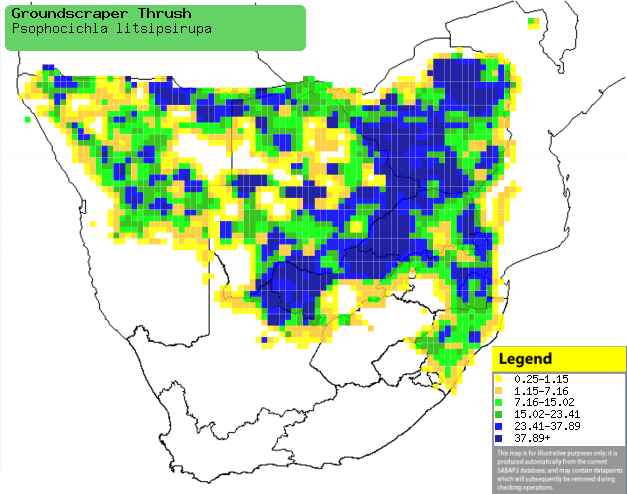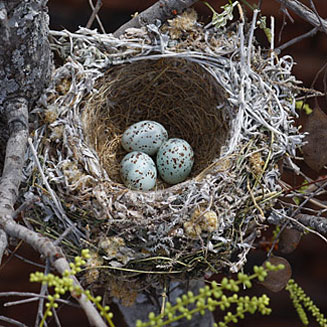|
Psophocichla litsitsirupa (Groundscraper
thrush)
[= Turdus litsitsirupa]
Gevlekte lyster [Afrikaans];
Mugendasikarapi (generic term for thrush) [Kwangali]; Xihandzamatala
[Tsonga]; Letsetserôpa, Letsotsonôpo [Tswana]; Merle litsipsirupa
[French]; Akaziendrossel [German]; Tordo-de-peito-malhado [Portuguese]
Life
> Eukaryotes >
Opisthokonta
> Metazoa (animals) >
Bilateria >
Deuterostomia > Chordata >
Craniata > Vertebrata (vertebrates) > Gnathostomata (jawed
vertebrates) > Teleostomi (teleost fish) > Osteichthyes (bony fish) > Class:
Sarcopterygii (lobe-finned
fish) > Stegocephalia (terrestrial
vertebrates) > Tetrapoda
(four-legged vertebrates) > Reptiliomorpha > Amniota >
Reptilia (reptiles) >
Romeriida > Diapsida > Archosauromorpha > Archosauria >
Dinosauria
(dinosaurs) > Saurischia > Theropoda (bipedal predatory dinosaurs) >
Coelurosauria > Maniraptora > Aves
(birds) > Order: Passeriformes
> Family: Muscicapidae
Distribution and habitat
It has two separate populations in sub-Saharan Africa; one
from Eritrea to Ethiopia and the other, larger population stretches from
Tanzania and southern DRC through Angola and Zambia to southern Africa. Here it
is locally common across much of the northern half of the region, generally
preferring open woodland, such as miombo (Brachystegia) and Mopane (Colosphermum
mopane), more rarely in fine-leaved Acacia woodland. It also occurs
in sandveld, gardens, playing fields and commercial orchards.
|
 |
|
Distribution of Groundscraper thrush in southern Africa,
based on statistical smoothing of the records from first SA Bird Atlas
Project (©
Animal Demography unit, University of
Cape Town; smoothing by Birgit Erni and Francesca Little). Colours range
from dark blue (most common) through to yellow (least common).
See here for the latest distribution
from the SABAP2. |
Food
It mainly eats insects, plucking them from ground with
short grass tufts, scratching and scraping in leaf litter. It occasionally
forages aerially, often taking insects flushed by bushfires. The following food items have been recorded
in its diet:
Breeding
- The nest (see image below) is a cup of which the composition varies from
region to region; it most commonly builds a bowl of pliable stems, but it
can also be built of grass, rootlets and weeds secured with spider web and
lined with feathers, or of leaves lined with midribs of Acacia
leaves. It is typically placed in a vertical or horizontal fork against the
tree trunk, often near the nests of
Fork-tailed drongos, as
it is thought that they take advantage of the drongo's aggressive nest
defence tactics.
 |
|
|
Groundscraper thrush nest with eggs, Modimolle,
South Africa. [photo Warwick Tarboton ©] |
|
- Egg-laying season is from August-March, peaking from September-November.
- It lays 2-4 eggs, which are incubated by both sexes for about 14-15
days.
- The chicks are cared for by both parents, leaving the nest after about
16 days. The fledglings usually remain dependent on their parents for 6
weeks after leaving, and they may even beg for food after their parents next
brood has hatched. The parents are extremely dedicated in their defence of
the young, sometimes attacking human intruders who come to close to the
nest.
Threats
Not threatened.
References
-
Hockey PAR, Dean WRJ and Ryan PG 2005. Roberts
- Birds of southern Africa, VIIth ed. The Trustees of the John Voelcker
Bird Book Fund, Cape Town.
-
Harrison, J.A., Allan, D.G., Underhill, L.G., Herremans, M.,
Tree. A.J., Parker, V. & Brown, C.J. (eds). 1997. The atlas of southern
African birds. Vol. 2: Passerines. BirdLife South Africa, Johannesburg.
|
